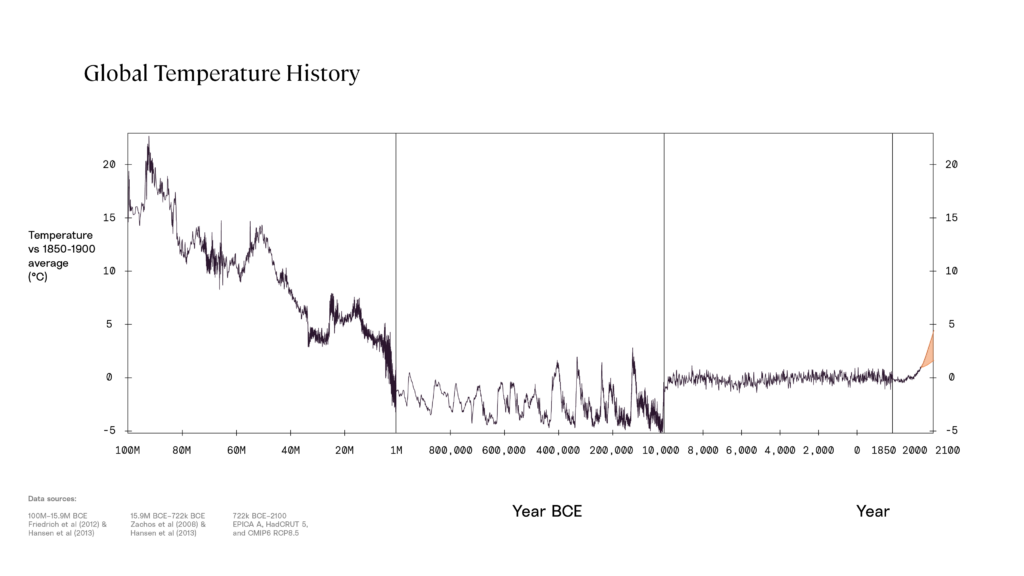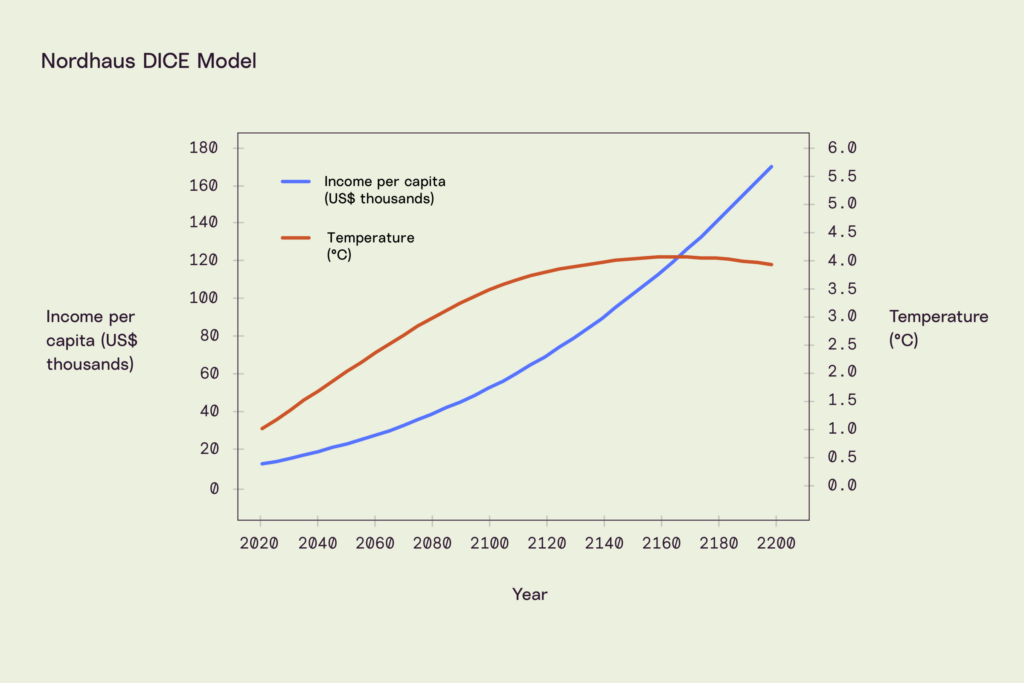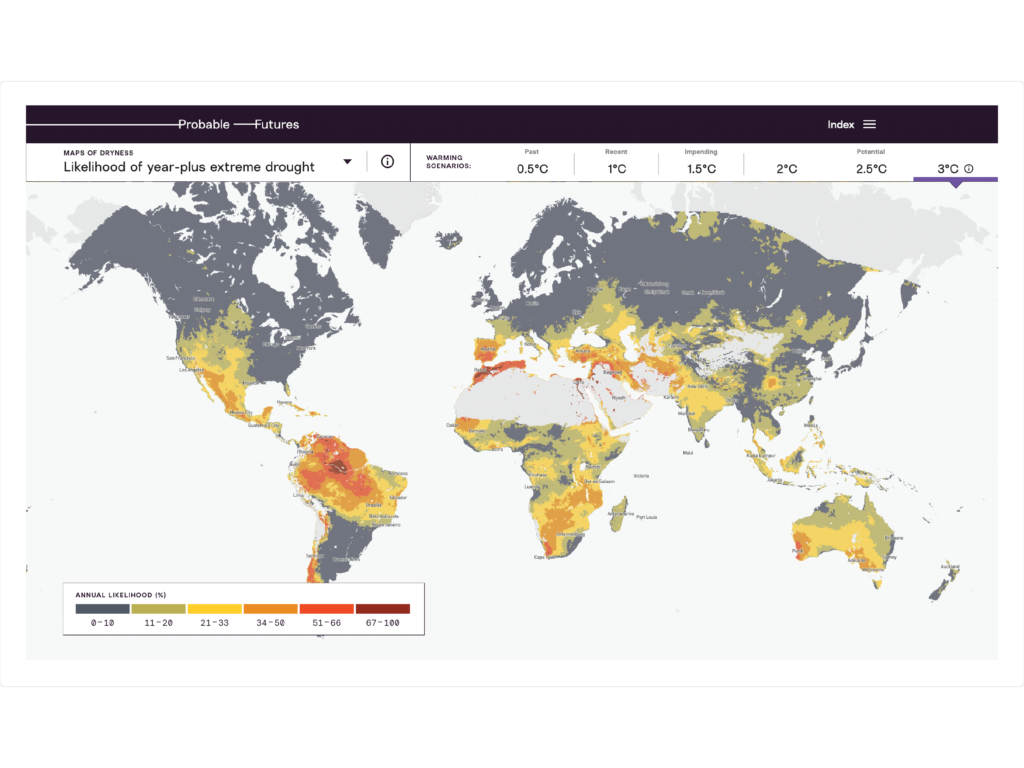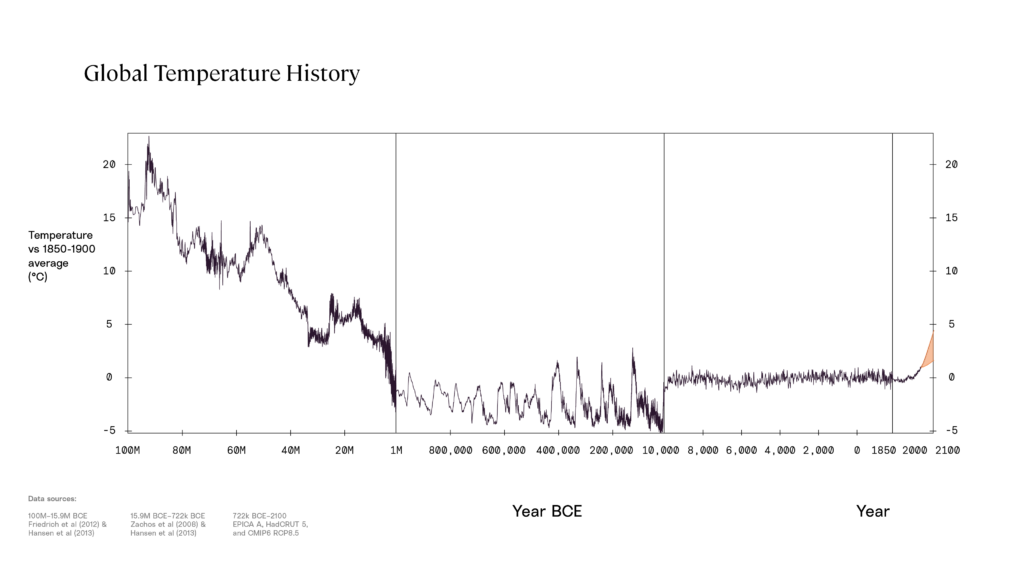Salutations à l'occasion du deuxième équinoxe de l'année 2020. Aujourd'hui, la Terre est en parfait équilibre par rapport au soleil, et tout le monde, partout, dispose de 12 heures entre le lever et le coucher du soleil. Pour ceux d'entre vous qui ne connaissent pas encore ces lettres, soyez les bienvenus. Je les publie à l'occasion des équinoxes et des solstices, car le cycle de l'un à l'autre reste constant, même si les saisons familières qu'ils annoncent sont en train de changer - l'un des nombreux schémas qui s'effondreront avec le changement climatique.
J'ai travaillé avec une grande variété de données pendant trois décennies, recherchant dans les registres de recensement, les comptes nationaux, les enquêtes auprès des entreprises et des particuliers, les statistiques commerciales, les archives nationales, les sources démographiques mondiales et autres, des modèles pour comprendre et expliquer comment et pourquoi les communautés, les villes, les pays, les entreprises et les industries en sont venus à avoir de bons ou de mauvais résultats et à prévoir ce que leur avenir pourrait leur réserver. Lorsque j'ai commencé à travailler dans le domaine de la finance, j'ai été frappé par le peu d'intégration de l'histoire dans la plupart des recherches. Souvent, les dix dernières années étaient considérées comme représentatives. Presque jamais les analyses ne s'appuyaient sur des périodes antérieures à la fin de la Seconde Guerre mondiale. Lorsque je posais la question, les chercheurs me répondaient que les périodes antérieures étaient trop volatiles, trop dissemblables ou qu'il y avait trop peu de données pour les inclure dans leur analyse. À l'ère de l'accélération exponentielle de l'information, nous disposons de plus de données sur la semaine dernière que sur l'ensemble de la vie avant 1945, de sorte que les données récentes sont largement exploitées. Les "big data" sont presque toujours des "données récentes". Ce serait une bonne chose si le passé récent offrait des informations précieuses, mais il y a un problème majeur à s'appuyer sur des données récentes pour préparer l'avenir, en particulier aux États-Unis : pendant de nombreuses décennies jusqu'à aujourd'hui, il ne s'est pas passé grand-chose.
Certains lecteurs de cette lettre s'opposent par réflexe à l'idée qu'il ne s'est rien passé pendant leur carrière. La crise financière mondiale de 2008-2009 était mondiale ! Et une crise ! C'est le point de référence le plus courant pour tous les résultats économiques potentiels, y compris le changement climatique. Mais dans les futurs livres d'histoire, il est peu probable que la crise financière mondiale justifie plus d'une page ou deux. Rétrospectivement, les graphiques des marchés boursiers montrent que 2009 a été une nouvelle occasion d'achat. Tous les revers subis au cours des dernières décennies ont été l'occasion pour les plus prospères de parier, une fois de plus, sur une plus grande prospérité à venir.
L'automne dernier, j'ai pris la parole devant un public d'administrateurs de fonds de dotation et de fondations, les personnes chargées de superviser certains des fonds les plus importants des États-Unis. Je leur ai demandé si leurs organisations avaient travaillé sur des sujets tels que la violence civile aux États-Unis, les catastrophes naturelles, l'effondrement du commerce mondial, les explosions nucléaires ou d'autres événements perturbateurs (à la dernière minute, j'ai omis les pandémies, pensant que je les perdrais). Je ne leur demandais pas si leurs organisations considéraient ces événements comme le "cas de base" de leurs investissements, mais je voulais simplement savoir si elles avaient organisé une seule réunion, chargé un seul stagiaire ou fait circuler un seul article ou un seul livre pour examiner les risques posés par ces éventualités. Aucun ne l'avait fait. Ils ne pouvaient pas imaginer que ces choses se produisent. Dans les années 1960, toutes ces questions auraient été des préoccupations actives, mais comme elles n'avaient pas eu lieu à l'âge adulte des membres de mon auditoire, elles relevaient de la science-fiction.
Le fait d'être ancré dans un passé récent biaise nos outils d'analyse et limite notre vocabulaire et notre imagination. Ce problème est à la fois le sujet de cette lettre et le centre de cette entreprise que nous appelons Probable Futures. Si, comme c'est souvent le cas dans le monde des affaires, vous voulez que j'aille à l'essentiel, le message est simple : le passé récent est peut-être la pire préparation possible pour ce qui est à venir. Les mentalités, les compétences et les modèles qui ont conduit au succès au cours des 75 dernières années risquent d'aboutir à des résultats désastreux à mesure que le climat change.
Stabilité
L'étude du climat et de sa relation avec la prospérité m'a permis de découvrir des séries de données merveilleusement longues. Les empereurs, les aristocrates, les gouverneurs et les moines du Japon ont enregistré le pic de floraison des cerisiers de Kyoto depuis au moins les années 800. Il y a eu des années plus chaudes et d'autres plus fraîches, mais en moyenne, sur près de 1 200 ans, le pic a été atteint autour du 15 avril. Ces dernières années, la moyenne se situait autour du 1er avril. Cette année, le pic a été atteint le 22 mars. Les prêtres shintoïstes croient que lorsque le lac Suwa gèle complètement, le dieu mâle Takeminakata traverse le lac pour rendre visite au dieu femelle Yasakatome. Selon des documents datant de 1443, la date de traversée de Takeminakata a varié régulièrement pendant plus de 500 ans ; il doit maintenant attendre environ cinq semaines de plus avant sa visite. En Nouvelle-Angleterre, où l'agriculture n'a jamais été facile, les gens ont bravé les éléments plusieurs fois par jour pour marquer le temps. En conséquence, nous savons que la "saison de croissance" entre la dernière gelée de printemps et la première gelée d'hiver est plus de trois semaines plus longue qu'elle ne l'était au cours des deux premiers siècles de relevés.
Probable Futures montrera quelles sont les limites qui seront franchies au fur et à mesure que nous nous éloignerons du climat dans lequel l'humanite a construit la civilisation. Nous sommes convaincus que quiconque prend le temps d'apprendre, de regarder autour de lui et d'imaginer comment les changements climatiques affecteront la vie comprendra mieux son monde, s'émerveillera davantage et appréciera l'urgence et les enjeux de la lutte contre le changement climatique. Ils verront également ce qui ne va pas dans les modèles qu'on leur a proposés ou qu'ils utilisent eux-mêmes.
Nous ne voyons pas ce qui ne bouge pas
On pourrait penser qu'il n'est pas nécessaire de sensibiliser les gens au monde physique dans lequel nous vivons, étant donné notre longue tradition d'enregistrement du temps qu'il fait et de discussions à ce sujet pour briser la glace métaphorique. Pourtant, la vie de nombreuses personnes est aujourd'hui tellement virtuelle - et presque entièrement à l'intérieur - que le monde physique est de plus en plus abstrait. En effet, nous le qualifions d'"extérieur". Il n'en a pas toujours été ainsi. Pour comprendre et anticiper les effets du changement climatique sur la civilisation, je pense qu'il est essentiel de se demander comment nous en sommes arrivés à considérer la nature comme extérieure à l'endroit où nous vivons. Il s'avère que la réponse se trouve dans la stabilité même des archives des cerisiers en fleurs.
Pendant environ 12 000 ans et jusqu'à ces dernières décennies, le climat de la Terre était presque parfaitement stable. Il y avait des années plus chaudes et des années plus froides, et en un lieu donné, il y avait des années "normales" et des années au cours desquelles des records étaient établis, mais l'amplitude des températures et des précipitations était limitée, et le rythme des saisons était le même qu'auparavant. Nous décrivions notre environnement avec ce que l'on appelle en anglais le présent simple, dans lequel le présent implique un état permanent : les Alpes sont couvertes de glaciers ; les cerisiers de Kyoto fleurissent en avril ; l'Inde reçoit 70 à 90 % de ses pluies pendant la saison de la mousson.
En général, je ne pense pas qu'il soit nécessaire d'être à l'aise avec les graphiques pour comprendre et apprécier le changement climatique. En effet, les chiffres avec des décimales sont souvent inutiles pour comprendre le problème. Il existe cependant un graphique que tout le monde devrait connaître, à savoir l'histoire de la température moyenne sur notre planète. Il est puissant, clair et explique notre existence. Le voici :

Le graphique est divisé en trois sections. La partie gauche montre la température moyenne de la Terre telle qu'elle a été reconstituée à partir de diverses sources entre 100 millions d'années et 1 million d'années. La partie centrale va de 1 million d'années à 12 000 ans, et la partie droite montre la période allant de 12 000 ans (10 000 avant notre ère) à 2100. L'axe vertical indique la température en °C par rapport à la période allant de 1850 à 1900, les années de formation des dirigeants actuels. Vous pouvez constater qu'il y a des dizaines de millions d'années, la Terre était beaucoup plus chaude que ce à quoi nous sommes habitués. En effet, il aurait probablement fait trop chaud pour que l'humanite puisse survivre, car notre corps de mammifère produit de la chaleur et a besoin d'être refroidi par notre environnement. Les reptiles, les amphibiens et les précurseurs de nombreux oiseaux étaient adaptés à ce climat. Puis, il y a environ 10 millions d'années, le climat a commencé à se refroidir, plongeant progressivement dans une période glaciaire.
Le panneau du milieu montre cette période glaciaire. Une période glaciaire est une période au cours de laquelle une grande partie des continents est recouverte par des glaciers. Le schéma régulier de refroidissement et de réchauffement de 0°C à -5°C et inversement correspond à des oscillations entre les maxima glaciaires - lorsque la glace recouvrait la majeure partie des terres - et les périodes "interglaciaires" plus chaudes, lorsque les glaciers se sont retirés dans les régions montagneuses et les zones proches des cercles arctique et antarctique. Ces cycles d'environ 100 000 ans ont été déclenchés par des changements de l'orbite et de l'axe de la Terre. L'Homo sapiens est apparu à cette époque, il y a environ 200 000 ans. Nos ancêtres sont nés dans un monde dont le climat changeait constamment. Il n'est donc pas surprenant qu'ils aient été mobiles et souvent nomades. L'un des principaux facteurs de la vie devait être la recherche des endroits où il faisait beau, car les endroits où il faisait beau se déplaçaient sans cesse.
Ce qui nous amène au dernier panneau. À partir d'environ 10 000 ans avant notre ère, le climat a fait quelque chose de remarquable : il s'est stabilisé dans une période interglaciaire. Un équilibre idéal a été atteint. La combinaison du pouvoir réfléchissant de la surface de la Terre (la glace renvoie la lumière du soleil dans l'espace) et de la composition de l'atmosphère (environ 285 ppm de CO2) convenait parfaitement à l'homo sapiens. Il y avait beaucoup d'endroits agréables, et ils sont restés sur place.
l'humanite Nous vivons dans la stabilité depuis si longtemps que nous avons beaucoup de mal à imaginer qu'elle puisse prendre fin. Mais ce qui est peut-être encore plus problématique, c'est la façon dont cette stabilité a été intégrée dans les outils que les experts utilisent pour enquêter, expliquer et conseiller, et les conteurs pour nous aider à nous connaître nous-mêmes. Les évaluations que vous avez certainement lues sur ce que sera l'avenir sont souvent pires qu'inutiles parce qu'elles ont été élaborées dans une période de stabilité et ne peuvent pas dépeindre un monde instable.
Modèles
Le modèle DICE (Dynamic Integrated Climate Change) est un outil couramment utilisé pour évaluer les coûts du changement climatique et les actions possibles pour l'atténuer. Son auteur, William Nordhaus de Yale, a remporté le prix Nobel d'économie en 2018, en partie pour ses travaux sur la productivité (son article le plus célèbre porte sur l'histoire du coût de l'éclairage artificiel) et en partie pour ses travaux sur l'économie du changement climatique. J'ai écrit un essai sur les lacunes de ces travaux, que vous pouvez trouver via un lien à la fin de cette lettre, mais une brève description des travaux devrait suffire ici.
Nordhaus et ses collègues prennent en compte les tendances économiques du 20e siècle, supposent que l'économie est effectivement une machine stable qui produit des biens économiques, et qu'elle le fera indéfiniment. La croissance de la productivité se poursuit à l'avenir, avec des baisses modestes du rythme de l'innovation dans un avenir lointain.
En bref, les modèles décrivent un avenir lointain qui s'inscrit dans la continuité de la trajectoire du 20e siècle, avec un lissage des parties désordonnées et l'ajout d'un changement climatique très progressif. Ce lissage est fondamental pour les modèles. Dans les années 1990, Nordhaus a proposé ce synopsis de scénarios avec un changement climatique modéré, un changement climatique dramatique et aucun changement climatique :
"Même s'il existe des différences entre les cas étudiés ici, la croissance économique globale prévue pour les années à venir éclipse les impacts prévus du changement climatique ou des politiques visant à compenser le changement climatique. Dans ces scénarios, les générations futures seront probablement moins bien loties en raison du changement climatique, mais elles seront probablement bien mieux loties que les générations actuelles.
Ces informations pourraient être précieuses si les modèles climatiques ou les modèles économiques qu'il utilise permettaient d'envisager de très mauvaises choses. Au lieu de cela, les émissions humaines sont les seules émissions dans ses modèles climatiques, et tous ses scénarios économiques offrent un arc de prospérité lisse et en pente ascendante. Voici la description que fait Thomas Schelling, collaborateur de Nordhaus, de cette question :
"Les modèles de réchauffement climatique ne prévoient que des changements graduels. Les climats "migreront" lentement. Le climat du Kansas peut se rapprocher de celui de l'Oklahoma, mais pas de celui de l'Oregon ou du Massachusetts. Mais une mise en garde s'impose : les modèles ne peuvent probablement pas prévoir de discontinuités parce qu'ils n'intègrent rien qui puisse produire des changements radicaux. Il existe peut-être des phénomènes susceptibles de produire des changements radicaux, mais ils ne sont pas connus avec suffisamment de certitude pour être introduits dans les modèles".
Je reformulerais cela comme suit : "Même si nous savons que des phénomènes discontinus (par exemple, d'énormes incendies de forêt, des troubles civils, l'effondrement des marchés financiers, une perte de confiance générale, un effondrement du commerce mondial) sont possibles, nous ne les avons pas observés récemment et ne disposons donc pas d'une estimation précise de ces phénomènes. Par conséquent, notre analyse ne les prend pas du tout en compte". Le modèle DICE est livré avec des paramètres par défaut. Voici les résultats qu'ils produisent :

Le revenu par habitant augmente infailliblement à mesure que la population atteint 11 milliards de personnes, de sorte que l'économie mondiale est beaucoup plus importante qu'aujourd'hui, et les températures dépassent les 3°C d'ici la fin du siècle pour atteindre un maximum d'environ 4°C. Dans le cadre de Nordhaus, tout le monde possède tellement de choses que cela ne les dérange pas d'avoir un climat différent.
Récemment, une organisation appelée The Climate Impact Lab a publié des travaux sur les conséquences de la chaleur extrême sur la mortalité. Un lien vers un Bloomberg sur ces travaux se trouve à la fin de cette lettre. Les résultats sont brutaux, mais je tiens à souligner une note de bas de page :
"La recherche du Climate Impact Lab ne reflète pas la possibilité d'une migration liée au climat. Comme l'indique cette étude, "les preuves empiriques existantes de migrations induites par le climat, basées sur les changements climatiques observables à ce jour, sont mitigées".
Les populations ne se sont pas récemment déplacées en masse en raison du changement climatique, bien que les preuves préhistoriques montrent clairement que le changement climatique passé a induit le nomadisme. Nos ancêtres nomades étaient peu nombreux et n'avaient pas de frontières nationales. Aujourd'hui, chaque espace vers lequel les migrants pourraient se déplacer est occupé par des personnes ayant des droits de propriété, ce qui représente un véritable défi économique. Pourtant, en l'absence de données récentes, l'analyse part du principe que la migration n'a pas lieu.
Les recherches d'Impact Lab sont beaucoup plus détaillées et étendues que celles de DICE, puisqu'elles portent sur des résultats tels que la mortalité humaine, mais, comme celles de Nordhaus, elles visent à utiliser les résultats récents pour prévoir les changements futurs afin de déterminer ce que le changement climatique devrait coûter en termes monétaires. Pour parvenir à ce prix, calculé au centime près, ces recherches partent également de l'hypothèse que les trajectoires sont lisses et excluent les perturbations probables les plus lourdes de conséquences. Pour paraphraser un collègue, ces modèles supposent que les enfants peuvent toujours aller à l'école, parce qu'à l'époque où ces modèles ont été estimés, ils le pouvaient toujours.
Gestion
W. Edwards Deming est sans doute l'un des penseurs les plus importants du XXe siècle. Il a promu des méthodes de travail conçues pour améliorer la qualité, réduire les déchets et améliorer les processus, en particulier dans l'industrie manufacturière. Ses travaux ont été rejetés par les entreprises américaines, mais adoptés au Japon, avec des résultats étonnants. Ces idées ont fini par revenir aux États-Unis, accompagnées d'une lecture sélective des idées de Deming. La plupart d'entre vous ont entendu des citations erronées de Deming : "Si vous ne pouvez pas le mesurer, vous ne pouvez pas le gérer". En fait, il soulignait le contraire, affirmant qu'il fallait mesurer ce que l'on pouvait mesurer, mais que "les chiffres les plus importants dont on a besoin pour la gestion sont inconnus ou inconnaissables, mais qu'une gestion réussie doit néanmoins en tenir compte".
Nous sommes dans une tragédie de la mesure, utilisant le passé comme guide pour un avenir dont nous savons qu'il sera radicalement différent. Ce problème est sur le point de se poser avec acuité en Californie. La science nous a avertis que les incendies allaient probablement s'aggraver. Dans un premier temps, les assureurs et les prêteurs, s'appuyant sur leur expérience passée, ont ignoré ces avertissements. Après les incendies de l'année dernière, les assureurs ont compris qu'ils devaient tenir compte de l'évolution de la science, ce qui les a incités à augmenter les prix et à refuser certains clients, mais l'autorité de régulation californienne est intervenue, interdisant de faire l'un ou l'autre pendant un an et obligeant les compagnies à n'utiliser que les données des incendies passés pour évaluer les risques. Cette année sera bientôt terminée, et lorsqu'ils seront contraints de n'utiliser que des données antérieures, les assureurs s'en iront, tout comme les prêteurs et les acheteurs potentiels.
Nous utilisons l'argent plutôt que le troc pour de nombreuses bonnes raisons, mais la meilleure est peut-être qu'une monnaie stable permet d'évaluer des choses très différentes d'une manière qui les rend comparables. Une unité monétaire capable d'accomplir cela s'appelle un numéraire. La logique du numéraire est au cœur de la plupart des analyses du changement climatique : le changement climatique entraînera tellement de changements difficiles à comparer, ne serait-il pas formidable de le réduire à un seul chiffre ? C'est pourquoi les initiatives scientifiques ont souvent confié leurs travaux à des économistes pour qu'ils les résument et en tirent des conclusions. C'est peut-être là l'aspect le plus tragique de l'influence et de la popularité croissantes de l'économie.
Les modèles économiques sont souvent des exercices intéressants, notamment parce qu'ils vous obligent à formuler des hypothèses et à réfléchir à la manière dont les choses fonctionnent, mais ils n'ont permis de prévoir l'avenir que lorsque celui-ci était lisse. Les modèles financiers des marchés boursiers et obligataires n'ont même pas besoin d'être bons pour être utiles. Si l'un d'entre eux est juste 60 % du temps, il peut rendre ses propriétaires fabuleusement riches. Pourtant, la science du climat a fait preuve d'une précision stupéfiante pendant plus de 40 ans et peut être utilisée pour dépeindre de manière saisissante ce qui se profile à l'horizon. Une grande partie de ce que ces modèles prédisent ne peut être évaluée.
Voici, par exemple, une carte de la probabilité d'une sécheresse extrême dans un climat plus chaud de 3°C que le climat stable dont nous avons hérité. Si le climat était stable, toute la carte serait incolore, car la probabilité d'une sécheresse extrême chaque année serait très faible. Au lieu de cela, vous pouvez voir que dans de nombreux endroits, en particulier dans les climats méditerranéens comme l'Europe du Sud, l'Afrique du Sud, les régions habitées d'Australie et la Californie, une telle sécheresse sera probable chaque année si nous n'arrêtons pas le réchauffement que nous provoquons. Ce climat spécifique, situé juste à côté d'un désert et d'un océan, recevant juste assez de pluie et juste assez de fraîcheur pour rester fertile, est susceptible de disparaître de la planète. Il est possible qu'il n'y ait plus jamais de Méditerranée. Que vaut cette perte ?

La science du climat peut être utilisée pour nous indiquer les conséquences probables de nos émissions de gaz à effet de serre. En prenant ces résultats physiques et en les passant au crible des modèles économiques et financiers construits pour décrire l'histoire récente, on force ce qui est manifestement sans précédent à se conformer aux précédents.
L'imagination
Je recommande vivement l'ouvrage The Great Derangement : Climate Change and the Unthinkable de l'écrivain Amitav Ghosh. Dans ce livre de non-fiction, Ghosh examine comment les normes culturelles modernes et la stabilité du climat et du passé récent ont limité ce qui est permis dans un autre outil important pour comprendre la vie : le roman. Ghosh considère le siècle des Lumières comme le point de départ de cette transition :
"...le dix-neuvième siècle a en effet été une époque où l'on supposait, tant dans la fiction que dans la géologie, que la nature était modérée et ordonnée : c'était la marque distinctive d'une vision du monde nouvelle et "moderne"... [Cette] victoire des vues gradualistes dans la science a également été remportée en caractérisant le catastrophisme comme non moderne."
Au fil du temps, la nature s'est de plus en plus éloignée de nos récits, si bien qu'au milieu du XXe siècle, la fiction ne parlait plus que de nous. Ghosh note avec dépit que :
"...c'est exactement à l'époque où l'activité humaine modifiait l'atmosphère de la Terre que l'imagination littéraire s'est radicalement centrée sur l'humain. Dans la mesure où le non-humain a été écrit, ce n'était pas dans le manoir de la fiction sérieuse, mais plutôt dans les toilettes extérieures où la science-fiction et la fantaisie avaient été bannies".
Ainsi, nous nous retrouvons avec des visions de l'avenir qui sont soit apocalyptiques, soit à peine différentes de celles d'aujourd'hui, et lorsque quelque chose d'inédit, mais pas si inattendu que cela, se produit, nous utilisons de plus en plus souvent la phrase familière suivante : "Si c'était dans un roman [ou un modèle, ou un mémo, ou une présentation PowerPoint, etc.
Nous avons besoin de nouvelles histoires, racontées par des romanciers, des cinéastes, des scénaristes de télévision et par chacun d'entre nous, des enfants à qui les enseignants demandent d'être créatifs aux adultes qui imaginent la vie future de leurs enfants. Voici des données qui pourraient inspirer de nouvelles histoires. Elles sont essentielles au fonctionnement de notre société, et tout le monde peut les comprendre et commencer à imaginer ce qu'elles signifient. Les cartes ci-dessous des jours annuels en dessous de zéro montrent comment l'expérience de l'"hiver" changera aux États-Unis si nous ne parvenons pas à maintenir le réchauffement en dessous de 3°C. Si vous regardez attentivement, vous verrez que les montagnes californiennes perdront leur neige, que les États du Sud seront chauds toute l'année, que la côte Est ne gèlera plus, etc. Il s'agit de détails spécifiques, mais l'image d'ensemble devrait être claire : partout dans le pays, le climat sera différent. J'aurais pu montrer n'importe quelle autre partie du monde et l'image aurait été comparable.
Jours de gel
L'extérieur entre en jeu
J'ai examiné à plusieurs reprises le graphique des températures que j'ai présenté au début de cet e-mail. Je pense qu'il vaut la peine de le montrer à nouveau et de se concentrer sur l'extrême droite. Nous sommes déjà à 1,1°C au-dessus de la période de longue stabilité, plus chauds que jamais depuis que l'humanite s'est installé. La dernière partie du graphique, à la fin, est d'une couleur différente et montre la voie sur laquelle nous sommes engagés. Comme vous pouvez le constater, il n'y a pas de précédent dans le reste de l'histoire pour une stabilité supérieure de 1°C à la moyenne interglaciaire.

Si nous dépassons les 2°C, il y a de bonnes raisons de penser que nous romprons à la fois notre stabilité récente et le cycle d'un million d'années dans lequel notre espèce a émergé. En effet, de nouveaux cycles ont déjà commencé, de la fonte du pergélisol à la disparition des glaciers. Chacun de ces phénomènes est une réponse à un climat plus chaud et crée un climat encore plus chaud, soit en ajoutant des molécules piégeant la chaleur dans l'atmosphère, soit en rendant la surface de la Terre moins réfléchissante, augmentant ainsi la chaleur que notre monde absorbe. Quelque part au-delà de 2 °C se trouve non pas une nouvelle stabilité, mais une trajectoire ascendante qu'il nous serait pratiquement impossible d'arrêter, et contrairement à la ligne orange ici, ou à pratiquement tous les modèles qui alimentent la discussion sur le "coût du carbone", il n'y a aucune raison de croire que cette trajectoire sera régulière. Au lieu de schémas familiers comme la saison des pommes ou la saison de ski, les jeunes d'aujourd'hui et les enfants de demain devront faire face à des saisons des incendies et des tempêtes de plus en plus longues, ainsi qu'à d'autres saisons que nous n'avons pas encore identifiées.
Nous avons besoin de nouveaux modes de pensée, et nous devons commencer à faire preuve d'imagination lorsque nous pensons au temps qui nous attend, à la vie que nous mènerons dans ce contexte, et à la manière dont nous préviendrons les pires conséquences. Les modèles de l'économie et de la finance modernes ne seront d'aucune utilité si nous ne les forçons pas à prendre en compte le fait que l'avenir sera différent du passé. Même dans ce cas, nous ne devrions pas les considérer comme des prévisions, mais comme des données d'entrée, et presque toujours des données d'entrée dans le meilleur des cas. De même, les modèles climatiques doivent être utilisés en tenant compte du fait que les risques en dehors des modèles sont disproportionnellement plus chauds et pires pour notre bien-être et la quasi-totalité de la vie qui nous entoure.
Ce qui est à venir
Dans ma dernière lettre, j'ai parlé des cartes interactives que Probable Futures proposera. Leur réalisation a pris un peu plus de temps que prévu, en grande partie parce que nos collaborateurs du Woodwell Climate Research Center ne cessent de trouver de meilleures façons de représenter ce qui se prépare, notamment en posant des questions telles que "Comment modéliser la saison des incendies dans un endroit qui n'en a jamais connu auparavant ? Le travail vaut la peine d'attendre un peu plus.
Vous ne devriez pas être surpris d'apprendre que Probable Futures n'offrira pas de prévisions précises et ne traduira jamais les résultats en valeurs monétaires. D'autres personnes sont invitées à le faire avec les outils que nous fournissons, mais nous leur conseillerons de le faire avec prudence, en tenant compte des risques. Notre plateforme et notre programmation informeront les gens en termes pratiques sur la chaleur, la sécheresse, les incendies de forêt, les précipitations et les tempêtes probables, et parraineront et encourageront les démonstrations de la manière dont ces phénomènes remettront en question la vie telle que nous la connaissons. Nous sommes encouragés par l'utilité de Probable Futureset nous travaillons dur avec nos partenaires pour construire une plateforme qui rendra l'information sur le changement climatique accessible, vivante, résonnante et utile. Notre ambition peut être imaginée comme une intervention sur ce même graphique : aider la ligne à se poursuivre dans l'avenir sans perdre sa stabilité.
C'est l'histoire de notre logo, conçu par nos collaborateurs de Moth Design :

La longue ligne et la plupart des lettres représentent le passé stable, dépeint par un violet riche, équilibré entre un rouge chaud et un bleu froid. À la fin, la couleur change. Ce changement ne doit pas nécessairement être plus chaud, de sorte que les lettres ne s'inclinent pas vers le haut, mais il doit être différent.
Nous espérons que vous vous joindrez à nos efforts.
En avant,

Spencer
Liens :
Voici l'article que j'ai écrit sur les modèles de Nordhaus
Voici l'article de Bloomberg sur la chaleur
Pour de rares exemples de fiction qui intègrent un imaginaire réaliste sur le changement climatique, je recommande lelivred'Omar el-Akkad intitulé La guerre américaine d'Omar el-Akkad et lelivrede Barbara Kingsolver Comportement de fuite. Toute autre recommandation est la bienvenue.